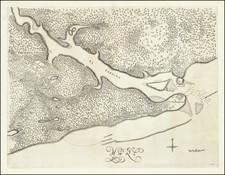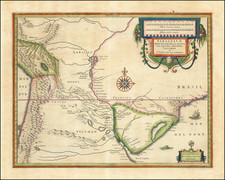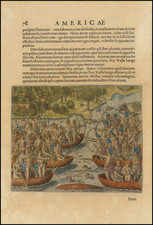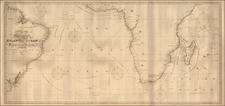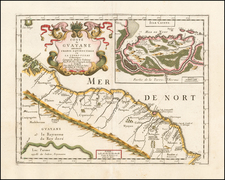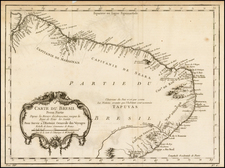Rare early view of the Dutch conquest of the Rio Grande in 1633.
This early view was later copied by Leti, who reversed the image, so that the title and landmass are at the right and the ship vignette is at the top left. While the Leti view appears periodically on the market, this edition is early quite rare.
The first European to reach the region may have been the Spaniard Alonso de Ojeda in 1499. The region was next visited during the the 1501-1502 Portuguese expedition led by Amerigo Vespucci. The Vespucci expedition named the Potengi (Tupi for "River of Shrimps") river, whose considerably large mouth contrasted with the nearby bodies of water, "Rio Grande" (Portuguese for "Great River"), after which the Captaincy, Province, and State were named.
Between 1535 and 1598, the region was explored by French pirates in search for Brazilwood. In 1598, the Portuguese built the Forte dos Reis Magos and, in the following year, founded the city of Natal.
In 1633, the area became a battleground between the expansionist Portuguese, seeking to take more land for their Brazilian territories, and the Dutch, who gained a foothold in South America. After a short period of peace and prosperity in Olinda and Recife, the sugar prices went down in the market of Amsterdam and the region entered into a serious economic crisis. The economic problems led the Portuguese settlers and native Brazilians to revolt against the Dutch in what is known today as the massacres of Cunhaú and Uruaçu.
The religious confrontations (the Portuguese-Brazilian Catholicism and the Dutch Calvinism), Portugal's restoration of the throne in 1640 and the reconquest of Maranhão in 1643, lead the Portuguese-Brazilians to undertake the 1645 uprising, led by André Vidal de Negreiros and João Fernandes Vieira. The governor of Bahia promised new Portuguese troops, but most of the rebels were Africans and Amerindians. In 1654, the Dutch were finally cast out.









